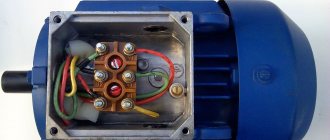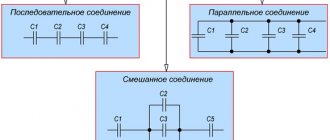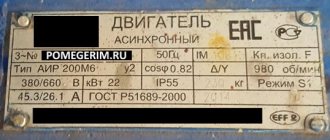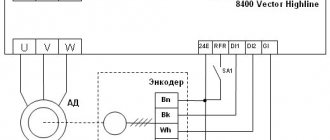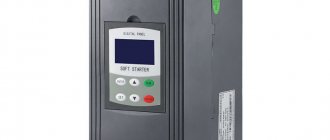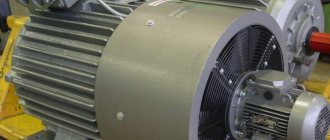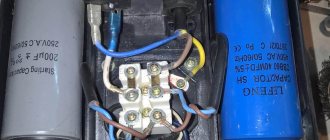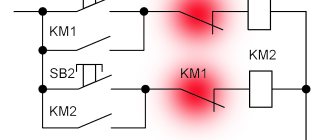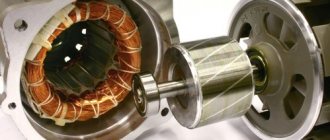How to calculate the power of an electric motor
- Calculations of the main parameters of an asynchronous electric motor
- How to determine the power of an electric motor?
- What types of regulators are there?
- Variable resistor regulator
- Electronic regulator
- Conclusion
How to calculate the power consumption of an asynchronous electric motor from the network if you can only find out the rated power from the nameplates? To do this you need:
- pay attention to the remaining indicators - these are η and cosφ (efficiency and power factor);
- take into account the relationship between the dynamic characteristics of the shaft and efficiency.
According to available data, it is possible to calculate the consumed electrical power:
P з=Р/η.
But we must remember that the energy consumed by electrical appliances includes both active and reactive components.
Estimated calculation for no-load current and voltage
The power of an electric motor can also be determined by current or, as amateurs say, “by amperage.” But measuring the current when the machine is under load in order to find out its rated power is incorrect, because you have no way of knowing whether it is working under rated load, overloaded, or vice versa, underloaded. The stator current depends on the load. This means that you will not measure the rated current, but the current consumption at this moment.
So, you need to measure the no-load current, that is, when the engine is running without load. Before you measure anything, to get the correct data you need to let it run for some time, namely 0.5-1 hour for engines up to 100 kW and 1-2 hours for engines above 100 kW. After the measurement, use the table to find out the typical deviations of Ixx from Ir as a percentage and calculate the expected Ir.
Let's give an example, let's say you measured the current, it turned out to be 5 Amps. We estimate the engine power “by eye”, let’s say that it is quite large, and you assume that it is more than 5 kW. Moreover, this is a “three-thousander”, that is, its shaft rotates at a frequency of 3000 rpm. Then the measured no-load current is 40% (or 0.4) of the rated current. To find out the rated current, you need to divide Iхх by percentages from the table:
Inom=Ixx/0.4=5/0.4=12.5A
Then the total and active power can be determined by the formulas:
S=UI*1.73=380*12.5*1.73=8217 W=8.2 kW.
Let us assume that the cosФ of the motor is 0.85, and its efficiency is 0.8, then the active P1 is equal to:
P = Iav*Uav*1.73*cosf*efficiency=12.5*380*1.73*0.85*0.8=5.5 kW
True, there are no standard asynchronous three-phase motors with such parameters, the numbers were taken only as an example, but using the above method you can find out the motor power, knowing the current and voltage.
Three-phase motor power calculation
Motor current calculation
Calculation of the rated current of a three-phase asynchronous electric motor
To correctly select the electrification system for a lifting and transport mechanism, be it a trolley busbar or cable supply, you need to know the rated current of the electrical installation.
Below is the calculation form for a three-phase AC induction motor:
In=Pn/√3*Un*cosφн*ηн or Pн/1.73*Un*cosφн*ηн,
where Рн is the rated power of the electric motor (W),
Un — rated voltage of the electric motor (V),
ηн - nominal efficiency of the engine,
cos φн is the rated power factor of the motor.
The rated data of the electric motor are indicated on the nameplate or in other technical documentation attached to the electric motor.
For convenience, here is an example of a calculation:
It is necessary to determine the rated current of a three-phase asynchronous AC electric motor if Рн = 25 kW, rated voltage Un = 380 V, rated efficiency ηн = 0.9, rated power factor cos φн = 0.8.
The rated voltage of the three-phase network is 380 V - the motor windings are connected in a star configuration. The rated voltage of a three-phase network is 220 V - the connection of the motor windings is in a delta pattern.
We convert the rated power from kW to Watts: Pn = 25 kW = 1000*25 = 25000 W
Next: In = 25000/√3*380 * 0.8 * 0.9 = 25000/1.73*380*0.8*0.9 = 52.8 A.
Share link:
- Click to share on Twitter (Opens in new window)
- Click here to share content on Facebook. (Opens in a new window)
- We recommend
- Comments
IP65 degree of tightness of equipment
IP rating (Ingress Protection Rating, input protection) is a system for classifying the degree of protection of the electrical equipment shell from the penetration of solid objects and water in accordance with the international standard IEC 60529 (DIN 40050, GOST 14254-96). For example, the radio control for the F21-E1B crane has a sealing class of IP-65. The first digit means
COPPER and COPPER ROLLED
Copper grades and their chemical composition are defined in GOST 859-2001. Brief information about copper grades is given below (the minimum copper content and the maximum content of only two impurities - oxygen and phosphorus are indicated): Grade Copper O2 P Production method, main impurities M00k 99.98 0.01 - Copper cathodes: product of electrolytic refiner.
Transferring the crane to control from the floor
Transferring the crane to control from the floor. When transferring overhead or gantry cranes to remote control from the floor, cable control panels or mongrel crane control panels can be used. The full list of operations and control systems of the crane cabin must correspond to the functionality of the console, in accordance with RD 24.09.
Trolley busbar HFP
Trolley busbar HFP Description - Contact-protected trolley busbar HFP H is designed for indoor and outdoor installation. — Busbars consist of a rigid PVC casing and copper conductors. The design of the busbar housing and current collector eliminates the possibility of phase reversal. — The current collectors are made in the form of a sliding, cold one.
How to choose the right capacitors
Many zealous owners who are accustomed to doing everything as much as possible with their own hands have to face this problem. Including collecting various equipment for household needs; for example, a circular saw on the site, an electric sander, a small lift in the garage, and the like.
Considering how much an electric motor costs, it is better to adapt the 3-phase sample at hand to work from 1ph, thereby adapting it to the home electrical network, than to purchase a new one. You just need to understand how and which electric motor is better to convert from 380 volts to 220, so as not to spend additional money, and understand the existing circuits for connecting them.
What to consider
- Converting from 380 to 220 makes sense if we are talking about an electric motor of relatively low power - up to 2.5, but not more (this is a maximum) 3 kW. In principle, there are no restrictions on this characteristic. But at the same time, most likely, you will need to carry out a number of activities and spend a certain amount of money and time.
- Relocate the power supply cable, and you will also have to negotiate with the electricity supplier in terms of increasing the limit. We should not forget that for private households there is a limit on en/consumption; usually 15 kW. Will a new load in the form of a powerful electric motor “fit” into it? Will the originally installed cable withstand it?
- For such a device, you need to lay a separate line from the power panel and install an individual machine, at a minimum. It’s unlikely that you’ll be able to simply connect it through an outlet; It's better not to experiment.
- The practice of rework shows that even if everything is done correctly, another problem will arise with the launch. The “start” of a powerful electric motor will be difficult, with prolonged build-up and voltage surges. Few people will be happy with this prospect, especially if something is being assembled not on a suburban site, but on the territory adjacent to a residential building. While the homemade installation based on this engine is functioning, malfunctions in the operation of household appliances will begin. Tested more than once.
- The procedure for reworking depends on the internal circuit of the electric motor. In some models, only 3 wires are output to the terminal box, in others - 6.
What is the difference? In the first case, the windings are already connected according to one of the traditional circuits - “star” or “delta”, so there are somewhat less possibilities for maneuver (in terms of modification).
There are few options - leave the original connection or disassemble the engine and reconnect the other ends. If all six are output, then you can connect them according to any of the schemes, without restrictions.
The main thing is to wisely choose the one that will be optimal for a specific situation (electric motor power, the specifics of its application).
The difference between a “triangle” and a “star” is described in detail on this page.
Theoretically, it is supposed to calculate the required capacity by dividing the current by the voltage and multiplying the resulting value by a coefficient. For different types of winding connections, the coefficient is:
- star – 2800;
- triangle - 4800.
The disadvantage of this method is that the data plate is not always preserved on the electric motor. It is impossible to know accurately the power factor and power of the motor, and therefore the current strength. In addition, the current strength can be affected by factors such as voltage deviations in the network and the amount of load on the motor.
Therefore, a simplified calculation of the capacitance of working capacitors should be used. Just keep in mind that for every 100 watts of power you need 7 microfarads of capacity. It is more convenient to use several parallel-connected capacitors of small, preferably the same capacity, than one large one. Simply summing up the capacitance of the collected capacitors, you can easily determine and select the optimal value. To begin with, it is better to underestimate the total capacity by ten percent.
If the engine starts easily and has enough power to operate, then everything has been selected correctly. If not, you still need to connect capacitors until the engine reaches optimal power.
It should be remembered that too much is not always good, and if the optimal capacity of the working capacitors is exceeded, the engine will overheat. Overheating can lead to burnout of the windings and failure of the electric motor.
It is advisable to choose capacitors with an operating voltage of at least 450 volts. The most common are the so-called paper capacitors, with the letter B in the name. Currently, specialized so-called motor capacitors are also produced, for example K78-98.
If the engine starts under load and is difficult, a starting capacitor is also needed. It is switched on in parallel with the working one for a short time when starting the electric motor. Its capacity should be equal to or not more than twice the worker's capacity.
Electric motor label
Having examined any electric motor, with rare exceptions, you can find a plate screwed onto bolts, screws or rivets. What is written on this piece of metal? Let's take a nameplate, replacing the serial number on it with the name of the site.
By the way, it rarely happens that a plate for electrical equipment is in such almost perfect condition. Often the data is faded or covered with paint, because the task is for the maintenance personnel to paint the engine, and not to paint the engine, leaving the plate untouched. But we were lucky. Let's go in order.
First line
- number of phases and type of current (3
), serial number, network frequency, design and installation form, insulation class
Second line
— type of electric motor, cosine phi, possible connection diagrams, rated speed
Third line
- possible rated voltages, rated power, IP - degree of protection of the electric motor, weight, operating mode of the electric motor (S1).
Fourth line
- rated currents depending on the winding connection circuit, then which guest the ed corresponds to.
Let's look at the individual parameters in more detail.
Electric motor power: total, active and shaft
Formula for calculating the power of a three-phase asynchronous motor:
S1 - total power consumed by the motor from the network
P1 - active power consumed by the electric motor from the network (indicated on the nameplate)
P is the active power on the EM shaft.
cosf - cosine phi, power factor - phase angle between active (P) and total power (S).
In the formulas above, the power value is obtained in W, the total power value in VA. To convert to kilowatts, you need to divide the resulting value by a thousand. The value of current and voltage, respectively, in the formula above is in amperes and volts.
I1 and U1 are linear values of current and voltage, they are also called phase-to-phase. Not to be confused with phase ones. Linear ones are AB, BC, SA (380); phase - AO, VO, SO (220). If we express the power formulas in terms of the phase values of current and voltage, then instead of the root of three there will initially be a coefficient of 3. This coefficient is determined visually through the vector diagram of the three-phase voltage.
For DC motors, the formula will simply be the voltage at the motor terminals multiplied by the current drawn by the motor from the network.
Power consumption p1 is greater than the power on the EM shaft due to losses that arise when converting electrical energy into mechanical energy.
Star/Delta and 220/380, 380/660
See all the values in order as they go through the fraction. That is, it is written on the nameplate Y/D (triangle/star), which means that the currents and voltages will accordingly be first for Y, and after the fraction for the star. The only caveat is that at 220/380 the triangle will be 220, and at 380/660 the triangle will be 380. That is, to say that 380 is always a star is incorrect.
Always read the label on the engine before connecting.
The advantages of star and delta connections are abstract, since each circuit has its own areas of application:
- Y - less operating and starting current, more voltage, less starting torque, less heat
- D - higher starting torque, starting current, but also heats up more.
There are two-speed engines, where they first start on a star, and then switch to a triangle. In this case, the mechanism starts up easier and then works with more power.
When connecting a three-phase 220V motor, where there is only a phase and a zero, you can resort to a circuit with capacitors.
Execution form and installation method
IM 1081 - form of execution and installation method in accordance with GOST 2479 and IEC60034-5. In our example, this means “foot-mounted with two end shields, with one cylindrical shaft end.”
If you couldn’t find out the power and rpm
If you are unable to find out the power and speed of the electric motors or you are not sure of the measurements, contact the specialists of Quality Systems. Our specialists will help you choose the right motor or repair a broken AIR motor.
The table provides information on the diameter of the electric motor shaft and its dimensions depending on the power and shaft speed.
The connecting dimensions of electric motors are given according to the GOST 2479-79 standard (“according to GOST”). On the domestic market there are electric motors with connection dimensions according to the DIN standard. In our practice, such electric motors are most often found as part of imported equipment.
The connecting dimensions according to GOST and DIN differ slightly. I wrote about these differences here.
And one more thing: the table shows the connection dimensions for a “standard” flange (IM 2081). Some electric motors can be equipped with a flange of reduced size (IM2181, about which our customers call it “small flange”). To clarify the dimensions of the “small” flange connection, please contact us.
Asynchronous electrical machines
In them, the magnetic field of the rotor is a product of the rotating magnetic field of the stator. Since there is an air gap between these machine parts, energy transfer between them occurs with losses. Therefore, the phase of the current in the rotor lags behind the phase of the current in the stator by a small angle (no more than 100), which determines the value of the power factor cosφ. This lag is the reason why an electric machine of this type is called asynchronous.
Squirrel-cage motors
Their rotor winding is a set of metal rods that connect two rings. The resulting figure is called a “squirrel wheel”. At the moment voltage is applied to the stator winding, a short circuit current arises in the rotor, the energy of which is spent on unwinding the shaft and is thereby extinguished. It has a slightly lower efficiency than synchronous machines, it does not exceed 80%.
After gaining speed, it has a very stable torque on the shaft and can withstand overloads well. The main advantages of such engines are their simplicity and reliability, thanks to which they are very widespread. Disadvantages: complexity of management.
To change the rotation speed, it is necessary to change the frequency of the supply voltage or the number of stator windings, which determines the number of poles of the electromagnet - the more there are, the lower it is. Also, electric motors with a squirrel-cage rotor are characterized by a large starting current that overloads the network, as well as a sharp increase in torque when power is connected, which can cause damage to the drive gearbox.
Wound rotor motors
The start-up of high-power squirrel-cage asynchronous motors (more than 30 kW) is associated with extreme overload of the supply network. To eliminate this phenomenon, machines with a wound rotor are used, the winding of which consists of three coils connected by a star. Their ends are connected by carbon brushes to three slip rings located on the motor axis.
FAQ on electric motors
1. What electric motors are used most often?
The most common are asynchronous electric motors with a squirrel-cage rotor. They have a relatively simple design and are relatively inexpensive.
To operate an asynchronous motor, a three-phase voltage is required, which creates a rotating magnetic field on the stator windings. This field drives the motor rotor, which transmits torque to a load, such as a fan propeller or conveyor gearbox. By changing the configuration of the stator windings, you can change the main characteristics of the drive - speed and shaft power. When an asynchronous electric motor operates in a single-phase network, phase-shifting and starting capacitors are used.
DC motors are also currently being used
. These drives have brushes that are subject to wear and sparking. In addition, a bias (excitation) winding is required, to which a constant voltage is applied. Despite these disadvantages, DC motors are used where rapid speed changes and torque control are required, as well as for powers above 100 kW.
Measuring power with a wattmeter
The power consumption of three-phase current is measured using wattmeters. This can be a special wattmeter for a 3-phase network, or a single-phase one connected according to a specific circuit. Modern electricity metering devices are often made using digital circuitry. Such designs are characterized by high measurement accuracy and greater capabilities for operating with input and output data.
Measurement options:
- Star connection with neutral conductor and symmetrical load - the measuring device is connected to one of the lines, the readings taken are multiplied by three.
- Asymmetrical current consumption in a star connection - three wattmeters in the circuit of each phase. The wattmeter readings are summed up;
- Any load and delta connection - two wattmeters connected in a circuit of any two loads. The wattmeter readings are also summed up.
In practice, they always try to make the load symmetrical. This, firstly, improves network parameters, and secondly, simplifies the accounting of electrical energy.
How to connect with reverse
To reverse the electric motor, it is necessary to change the direction of rotation of the magnetic field. When starting a motor without capacitors, it is first given the required direction of rotation manually, and in the capacitor circuit the capacitance is switched from the neutral wire to the phase wire. This is done by a toggle switch, switch or contactors.
Reverse capacitor motor
Important! Starting capacitors are connected in parallel with the working capacitors and switch when the direction of rotation changes simultaneously with them.
Ensuring that the rotor rotates in the opposite direction is not difficult. A two-position switch must be added to the motor wiring diagram. The middle contact of the switch is connected to one of the contacts of the capacitors, and the outer ones to the motor terminals.
The considered options for connecting industrial motors to a household network do not present much difficulty in their implementation. It is only important to pay close attention to some nuances and the equipment, although with a slight loss of power, will last a long time and be beneficial.
How to correctly calculate the power of a three-phase network
In order to find out the power of electricity consumed by voltage and current, you need to know how much energy is consumed. To do this, you need to compare all the energy consumers used (you can find out the amount of energy consumed by a particular item by reading the information on the tag, case or passport data of the device).
You should also know your type of power in a three-phase circuit: uniform (symmetrical) or uneven (asymmetrical).
With an asymmetrical load, the current in all phases is different. For example, if a building is illuminated using a three-phase network, where all 12 lamps are lit in the first row, in the second row the 6th lamp is not lit, and in the last row the 11th lamp is not lit.
In such a situation, you need to use clamps to separately determine the current in all phases.
Calculations of the main parameters of an asynchronous electric motor
Active power is spent to perform useful work and create heat. Denoted by the letter " P ", measured in W and calculated:
P = I * U * cos φ.
Reactive power is created by fluctuations in the energy of the electric field. It determines the ability of jet engine parts to store and emit electromagnetic energy. We are talking about the current that charges a capacitor or creates a magnetic field around the turns of a coil winding. Denoted by the letter " Q ", measured in Var and calculated:
Q=I*U*sinφ.
The total power " S " is represented by a mathematical combination according to the formula of the Pythagorean theorem: S*S = Q*Q + P*P . It is measured in V*A and is calculated:
S = P / cos φ = √(P 2 + Q 2 )=I*U.
The reactive power of a three-phase asynchronous motor can be represented as the sum of two components: inductive and capacitive.
